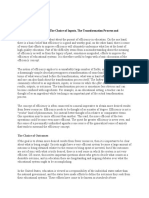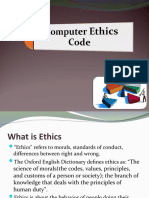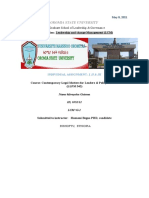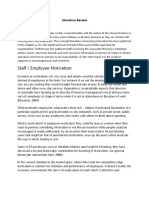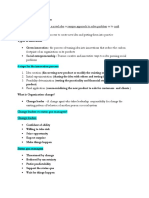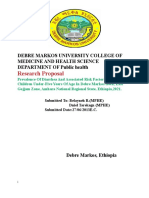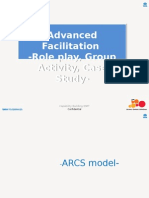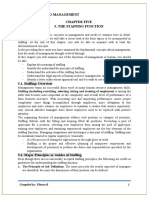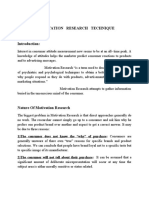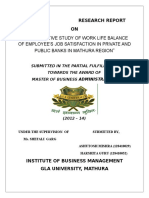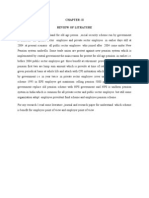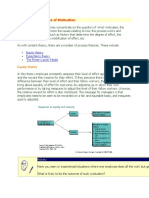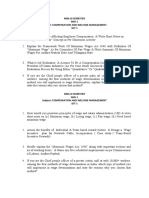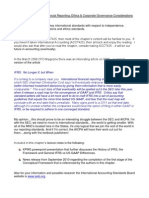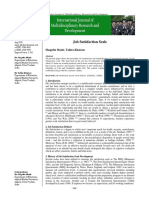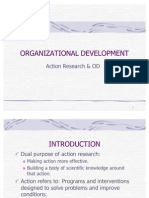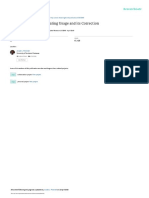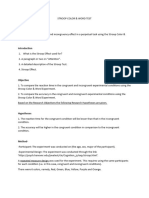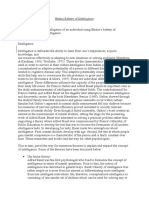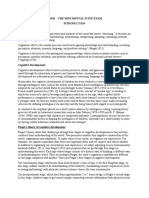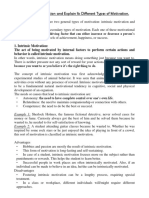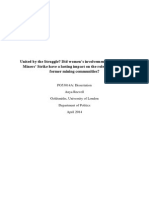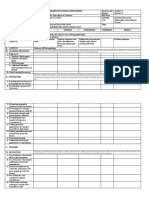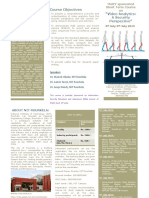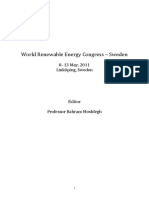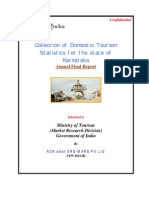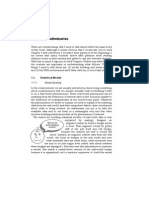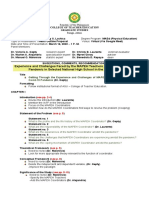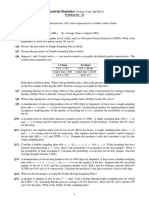Professional Documents
Culture Documents
What Is Likert Scale
What Is Likert Scale
Uploaded by
Sanya GoelOriginal Description:
Original Title
Copyright
Available Formats
Share this document
Did you find this document useful?
Is this content inappropriate?
Report this DocumentCopyright:
Available Formats
What Is Likert Scale
What Is Likert Scale
Uploaded by
Sanya GoelCopyright:
Available Formats
What is likert scale?
Paul E. Spector (1994): In his book "Using Self-Report Questionnaires in OB
Research: A Comment on the Use of a Controversial Method," Spector
discussed the Likert scale as a widely used technique in organizational behavior
research to gauge participants' attitudes or opinions.
Likert Scale Types
Researchers who want to gather feedback on employee or customer
satisfaction frequently use the Likert Scale. This scale can be broadly classified
into two categories:
Likert scales: Even, Odd
Even Likert Scale: Without offering a neutral option, researchers gather
extreme feedback using even Likert scales.
A 4-point Likert scale for importance enables researchers to include four
extreme options in their analysis without providing a neutral option. Here, a 4-
Point Likert Scale is used to represent the various degrees of importance.
Eight-Point Probability of recommendation: This is a modified 4-point Likert
scale, with eight options to gauge the likelihood of a recommendation. That is
the only modification from the previous explanation.
Odd Likert Scale : Researchers offer respondents the option to respond
neutrally by using the odd Likert scale.
5-point Likert scale: This unusual Likert scale question has five answer options.
Researchers use it to collect data on a topic by giving respondents the option to
select a neutral response if they would prefer not to answer from the extreme
choices in their research design.
Seven-point Likert scale: At the extremes of a five-point Likert scale question,
the seven-point Likert scale adds two more response options.
9-point Likert scale: Although they are not very common, you can use a 9-point
Likert scale by giving the 7-point Likert scale question two more answer
choices.
DATA ANALYSIS FROM A LIKERT SCALE
Likert-derived data can be treated either as ordinal-level or interval-level
data
Ordinal data: You find the mode, or most common score, for each question to
get a general idea of your sample. To see the frequency of each item choice,
you can also make a bar chart for each question.
You postulate that believing that environmental damage is a significant issue is
correlated with knowledge of climate change. The chi-square test of
independence is used to determine whether these two characteristics are
related.
Interval data: The total score for each participant is obtained by adding the
scores from each question. For your sample, you determine the standard
deviation, or spread, and the mean, or average, score.
You look into the relationship between attitudes toward eco-friendly behavior
and age. You determine whether there is a relationship between age and the
overall score on your Likert scale by using a Pearson correlation test.
Likert-derived data is typically analyzed at the ordinal level, where response
categories are presented in a ranking order, but the distances between
categories cannot be assumed to be equal. For instance, a scale with 1 =
strongly agree, 2 = agree, 3 = neutral, 4 = disagree, and 5 = strongly disagree
can be analyzed as such. Descriptive statistics can be used to summarize the
data in numerical or visual form, with the median or mode used as the
measure of central tendency. Bar charts can be created to visualize the
frequency of each item choice. Inferential statistics for ordinal data include
Spearman’s correlation or a chi-square test for independence.
Another approach is to analyze Likert-derived data at the interval level, where
response categories are presented in a ranking order and the distance between
categories is presumed to be equal. Inferential statistics like analysis of variance
(ANOVA) or Pearson’s correlation can be used, provided the data is at the
interval level. Descriptive statistics involve adding up scores from each question
to find the mean and standard deviation of the scores for the sample.
ADVANTAGES AND DISADVANTAGES OF LIKERT SCALE
Likert scales are frequently used in research because of their adaptability and
simplicity of use, but they also have a unique set of benefits and drawbacks.
Advantages
Versatility: Likert scales are adaptable for a variety of research purposes
because they can be used to measure attitudes, opinions, perceptions, and
preferences on a wide range of topics. Example Study: Johnson et al. (2018)
measured employees' job satisfaction across a range of industries using Likert
scales. The researchers discovered that the wide range of attitudes and
opinions regarding various aspects of the work environment could be captured
by using Likert scales.
Quantitative Information: Likert scales yield quantitative information that can
be analyzed statistically to produce means, standard deviations, and
correlations. This information helps researchers to draw conclusions and
compare findings. Example Study: To gauge consumer satisfaction with a new
product, Smith et al. (2020) used Likert scales. The researchers were able to
spot trends in consumer preferences and make data-driven decisions to
enhance the product by quantitatively analyzing the Likert scale responses.
Ease of Interpretation: Because Likert scale responses frequently employ
simple, unambiguous language, they are generally simple for researchers and
respondents to interpret and comprehend. Example Study: Likert scales were
used to gauge student satisfaction with platform usability in a Chen et al.
(2019) study on students' impressions of online learning platforms. The simple
Likert scale responses made it easier to understand the preferences of the
students and provided direction for platform interface enhancements.
Standardization: Because Likert scales have a consistent format, comparing
responses from various people, groups, or periods of time is made simpler.
Example Study: Johnson and Smith (2017) used Likert scales to measure
attitudes toward environmental conservation in a cross-cultural study. Likert
scales gave a standard format for comparing attitudes across nations, even
though respondents' cultural backgrounds varied.
Effectiveness: Likert scales are useful for gathering data from large samples or
in circumstances where time is of the essence because they are comparatively
quick and simple to administer. Example Study: Using Likert scales to gauge
adherence to preventive measures, Williams et al. (2021) carried out a
comprehensive survey on public health behaviors during the COVID-19
pandemic. The researchers were able to swiftly gather and examine data from
a wide range of participants thanks to the effectiveness of Likert scales.
Disadvantages:
Restricted Response Options: Likert scales usually provide a set number of
response options, which might not fully convey the nuance of respondents'
views or opinions. Limited Response Options: Example Study: Jones et al.
(2019) investigated attitudes towards animal welfare using a Likert scale
with only three response options (Agree, Neutral, Disagree). The limited
response options hindered the researchers' ability to capture nuanced
attitudes towards different animal welfare policies.
Response Bias: The validity and dependability of the data may be impacted by
respondents' propensity to give socially acceptable or neutral answers, among
other response biases.
Difficulties with Interpretation: Although Likert scales offer numerical data,
interpreting the significance of particular response categories can occasionally
be subjective, especially in cases where responses are unclear or contingent on
context. Example Study: Smith and Brown (2018) examined employee
perceptions of organizational culture using Likert scales. However,
varying interpretations of Likert scale items led to discrepancies in
respondents' ratings, highlighting the challenge of interpreting
responses accurately.
Order Effects: The arrangement of items on a Likert scale can affect how
respondents interpret the questions and how they respond, which could
introduce order effects into the data that could cause confusion. Example
Study: In a study by Lee et al. (2020) on consumer preferences for
sustainable products, Likert scale items were presented in different
orders across survey respondents. The researchers found that the order
in which items were presented influenced respondents' ratings,
indicating potential order effects
Cultural Differences: Likert scales might not be appropriate for all cultures or
demographics as response patterns and interpretations of scale points can vary
culturally
You might also like
- MGMT807 - Organisational Behaviour S1 2021 Study GuideDocument18 pagesMGMT807 - Organisational Behaviour S1 2021 Study GuideHany A AzizNo ratings yet
- GuidelinesforResearch IntroductoryDocument14 pagesGuidelinesforResearch IntroductoryKainat BatoolNo ratings yet
- Explain The Difference Between Invention and Innovation. Which Do You Consider The Most Important and Why? 10p - 250 WordsDocument4 pagesExplain The Difference Between Invention and Innovation. Which Do You Consider The Most Important and Why? 10p - 250 WordsEmaNo ratings yet
- Chapter5 Summary CSRDocument6 pagesChapter5 Summary CSRAbid IqbalNo ratings yet
- Efficiency in EducationDocument7 pagesEfficiency in Educationmuna moonoNo ratings yet
- Leatham Management PlanDocument2 pagesLeatham Management Planapi-264716980No ratings yet
- IEEE Code of Ethics For The Software Engineer EthicsDocument40 pagesIEEE Code of Ethics For The Software Engineer EthicsMaria ChNo ratings yet
- Dedication: Chameleon Heels (A Project of Pvt. LTD)Document31 pagesDedication: Chameleon Heels (A Project of Pvt. LTD)Muhammad Osama Ashraf100% (1)
- Measuring Job SatisfactionDocument10 pagesMeasuring Job SatisfactionKeyza C. VicenteNo ratings yet
- Multi Stage SamplingDocument4 pagesMulti Stage SamplingSachin Sharma0% (1)
- UNIT 5 Social & Behavioral ComDocument4 pagesUNIT 5 Social & Behavioral ComKouame AdjepoleNo ratings yet
- Unit 2 Philosophical Aspects of ManagementDocument42 pagesUnit 2 Philosophical Aspects of ManagementarbindshrNo ratings yet
- Neo-Classical Theory - Aquino, Kristel AnneDocument15 pagesNeo-Classical Theory - Aquino, Kristel AnneKristel Anne AquinoNo ratings yet
- AnswerDocument16 pagesAnswerhasini83% (6)
- LIkert Scale - NormalityDocument11 pagesLIkert Scale - NormalityRashmi VaishyaNo ratings yet
- Job Enrichment, Job Enlargement, Job Analysis & Job RotationDocument23 pagesJob Enrichment, Job Enlargement, Job Analysis & Job RotationriyahasiniNo ratings yet
- Oromia State University: Specialization: Leadership and Change Management (LCM)Document19 pagesOromia State University: Specialization: Leadership and Change Management (LCM)Missael Ayalew100% (1)
- Melaku Berhanu Thesis-Final - NewDocument111 pagesMelaku Berhanu Thesis-Final - Newmela berNo ratings yet
- Literature Review MotivationDocument4 pagesLiterature Review MotivationSwarnajeet GaekwadNo ratings yet
- Ururka Dastuur TusaaleDocument13 pagesUrurka Dastuur TusaaleibrahimNo ratings yet
- CH-7 Managing Growth & TransitionDocument39 pagesCH-7 Managing Growth & Transitionbesedegefub9131No ratings yet
- Institute of Business ManagementDocument18 pagesInstitute of Business ManagementMehwish LadhaniNo ratings yet
- Contemporary Management - NotesDocument6 pagesContemporary Management - NotesMahmoud NassefNo ratings yet
- Herzberg's Two Factor TheoryDocument20 pagesHerzberg's Two Factor Theoryimaginatorzzz100% (1)
- Debre Markos University College of Medicine and Health ScienceDocument29 pagesDebre Markos University College of Medicine and Health ScienceYitbarek GuadieNo ratings yet
- Advanced Facilitation-Role Play, Group Activity, Case StudyDocument19 pagesAdvanced Facilitation-Role Play, Group Activity, Case StudyAmit GuptaNo ratings yet
- Employee Motivation Research MetodologyDocument19 pagesEmployee Motivation Research MetodologyPratik LokhandeNo ratings yet
- Introduction To Management Chapter Five 5. The Staffing Function Chapter ObjectivesDocument13 pagesIntroduction To Management Chapter Five 5. The Staffing Function Chapter ObjectivesfitsumNo ratings yet
- Marketing ResearchDocument21 pagesMarketing ResearchEbsa Ademe100% (1)
- Human Resource Department Functions in State Bank of PakistanDocument72 pagesHuman Resource Department Functions in State Bank of PakistanInfinityIcon100% (3)
- BD Hypothesis Testing WSDocument4 pagesBD Hypothesis Testing WSAdarsh KumarNo ratings yet
- Group 2-HRM AssignmentDocument25 pagesGroup 2-HRM AssignmentIsubalew DabaNo ratings yet
- Difference Between Questionnaire and In... TH Comparison Chart) - Key DifferencesDocument10 pagesDifference Between Questionnaire and In... TH Comparison Chart) - Key DifferencesMac SensNo ratings yet
- Performance ManagementDocument50 pagesPerformance ManagementVasanthi Donthi100% (2)
- PGDMLM PapersDocument10 pagesPGDMLM PapersAakash Singh0% (1)
- Motivational Research TechniqueDocument9 pagesMotivational Research Techniquemoiz_tiger100% (3)
- Entrepreneurship Course OutlineDocument2 pagesEntrepreneurship Course Outlinekedir AbrahimNo ratings yet
- Paternalistic Leadership Style HandoutDocument4 pagesPaternalistic Leadership Style HandoutOckouri BarnesNo ratings yet
- WLB ReportDocument18 pagesWLB ReportDr-Shefali GargNo ratings yet
- My Literature ReviewDocument10 pagesMy Literature ReviewPawan Kumar DubeyNo ratings yet
- Ethics Case AssignmentDocument21 pagesEthics Case Assignmentfatinzalila100% (1)
- Introduction To Statistics - Doc1Document236 pagesIntroduction To Statistics - Doc1adaneabera95No ratings yet
- The Process Theories of MotivationDocument22 pagesThe Process Theories of MotivationjanNo ratings yet
- QuestionnaireDocument11 pagesQuestionnairenavin_raghuNo ratings yet
- PGDHM SyllabusDocument37 pagesPGDHM Syllabusnayra khan0% (1)
- Mid-1 Mba III Semester Compensation and Welfare ManagementDocument1 pageMid-1 Mba III Semester Compensation and Welfare ManagementBhaskaran BalamuraliNo ratings yet
- Leading Change: & Uncertain TimesDocument11 pagesLeading Change: & Uncertain TimeshesnaeNo ratings yet
- Chapter 8 Lecture NotesDocument7 pagesChapter 8 Lecture NotesnightdazeNo ratings yet
- D1 - Wellness Program PDFDocument35 pagesD1 - Wellness Program PDFBea Sophia Belleza SolonNo ratings yet
- Task ConflictDocument3 pagesTask ConflictDhiraj RawalNo ratings yet
- Role of MisDocument25 pagesRole of MisSantosh Kumar JoshiNo ratings yet
- Module 5Document6 pagesModule 5AllanCuartaNo ratings yet
- Job Satisfaction Scale: Shagufta Munir, Tahira KhatoonDocument4 pagesJob Satisfaction Scale: Shagufta Munir, Tahira KhatoonrlynmndzNo ratings yet
- Organizational Development: Action Research & ODDocument12 pagesOrganizational Development: Action Research & ODmbacallingNo ratings yet
- Chapter - 3: Measures of Central TendencyDocument80 pagesChapter - 3: Measures of Central TendencyDesyilalNo ratings yet
- The Four Walls: Live Like the Wind, Free, Without HindrancesFrom EverandThe Four Walls: Live Like the Wind, Free, Without HindrancesRating: 5 out of 5 stars5/5 (1)
- 9874 29375 1 PBDocument10 pages9874 29375 1 PBKatrine Visitacion Dela CruzNo ratings yet
- Basic Stat NarrativeDocument9 pagesBasic Stat NarrativeeL LeahNo ratings yet
- Stroop ExperimentDocument2 pagesStroop ExperimentSanya GoelNo ratings yet
- T Test PaperDocument16 pagesT Test PaperSanya GoelNo ratings yet
- Optimism and Risk Taking AkshiDocument7 pagesOptimism and Risk Taking AkshiSanya GoelNo ratings yet
- Bhatia Battery of IntelligenceDocument17 pagesBhatia Battery of IntelligenceSanya Goel100% (1)
- MMSE Cognitive ImpairmentDocument5 pagesMMSE Cognitive ImpairmentSanya Goel100% (1)
- ASP Practicum Part1Document30 pagesASP Practicum Part1Sanya GoelNo ratings yet
- Ethics in Digital CommunicationDocument12 pagesEthics in Digital CommunicationSanya Goel100% (1)
- ASP Practicum Part2Document5 pagesASP Practicum Part2Sanya GoelNo ratings yet
- Statistical Methods in Econometrics Ramu RamanathanDocument416 pagesStatistical Methods in Econometrics Ramu RamanathanantoniorsilvaNo ratings yet
- Q: 11 - What Is Motivation and Explain Its Different Types of MotivationDocument4 pagesQ: 11 - What Is Motivation and Explain Its Different Types of MotivationirfanNo ratings yet
- The TATA GroupDocument8 pagesThe TATA GroupPragati srivastavaNo ratings yet
- United by The Struggle? Did Women's Involvment in The 1984-5 Miners' Strike Have A Lasting Impact On The Role of Women in Former Mining Communities?Document48 pagesUnited by The Struggle? Did Women's Involvment in The 1984-5 Miners' Strike Have A Lasting Impact On The Role of Women in Former Mining Communities?anyagraceNo ratings yet
- Socioeconomic Problems Among Migrant Laborers Working in Construction SitesDocument6 pagesSocioeconomic Problems Among Migrant Laborers Working in Construction SitesRh SamsserNo ratings yet
- DLL Intro To PhiloDocument3 pagesDLL Intro To PhiloMaro Mempin-TabinasNo ratings yet
- Dr. Reddy's Corporate PresentationDocument35 pagesDr. Reddy's Corporate Presentationbiswajitd100% (2)
- Comparative Study of Fans in A MarketDocument25 pagesComparative Study of Fans in A MarketAditi jainNo ratings yet
- STC Video AnalyticsDocument2 pagesSTC Video AnalyticsSufyan KhanNo ratings yet
- Quantitative Data Gathering Techniques: September 2016Document10 pagesQuantitative Data Gathering Techniques: September 2016Gisela BccNo ratings yet
- Ecp057vol6 PDFDocument107 pagesEcp057vol6 PDFjebicoreNo ratings yet
- Ramat Roma 2007 Europe and The Mediterranean As Linguistic AreasDocument393 pagesRamat Roma 2007 Europe and The Mediterranean As Linguistic AreasIker SalaberriNo ratings yet
- Cardinaels 2018 Tournament Prize Spread Information Experiments PDFDocument24 pagesCardinaels 2018 Tournament Prize Spread Information Experiments PDFeagle fly10No ratings yet
- Report On BeroeDocument29 pagesReport On BeroeRenish MosesNo ratings yet
- Karnataka Tourism Statistics.Document128 pagesKarnataka Tourism Statistics.jangegNo ratings yet
- Innovative Crisis Management in Construction: Approaches and The ProcessDocument8 pagesInnovative Crisis Management in Construction: Approaches and The ProcessAnas TariqNo ratings yet
- Data Driven Governance Competency Guide: Resource PersonDocument67 pagesData Driven Governance Competency Guide: Resource PersonJayson VelascoNo ratings yet
- Hannah HildebrandtDocument1 pageHannah Hildebrandtapi-325782565No ratings yet
- QCM Franck Mathot - Competitive Intelligence 30 Min 2013Document2 pagesQCM Franck Mathot - Competitive Intelligence 30 Min 2013MouradNo ratings yet
- Dissertation PPT TemplateDocument7 pagesDissertation PPT TemplateAcademicPaperWritingServicesSingapore100% (1)
- Field2000 (Chapter1) PDFDocument32 pagesField2000 (Chapter1) PDFquaser79No ratings yet
- Iea 4e Emsa Energy Audits For Motor Driven Systems Part1Document64 pagesIea 4e Emsa Energy Audits For Motor Driven Systems Part1Al BenNo ratings yet
- Experience and Challenges Faced by The MAPEH Teachers Amidst The Covid-19 Pandemic in Selected National High School in The District of NabasDocument3 pagesExperience and Challenges Faced by The MAPEH Teachers Amidst The Covid-19 Pandemic in Selected National High School in The District of NabasMary MAy Salvadico LachicaNo ratings yet
- Attitudes and Behaviour Regarding Deep Dentin Caries Removal: A Survey Among German DentistsDocument9 pagesAttitudes and Behaviour Regarding Deep Dentin Caries Removal: A Survey Among German DentistsNaji Z. ArandiNo ratings yet
- X. Responding To Transgender Victims of Sexual Assault.2014.Document140 pagesX. Responding To Transgender Victims of Sexual Assault.2014.Sarah DeNo ratings yet
- Tutorial Sheet 2 1Document1 pageTutorial Sheet 2 1Jhansi ReddyNo ratings yet
- Determining Embedment Response Parameters From Connector TestsDocument6 pagesDetermining Embedment Response Parameters From Connector Tests王向杰No ratings yet
- 333Document9 pages333Nelle christine TanguilanNo ratings yet
- 2022 - JIMSA - Role of Coping and Psychological Well-Being in Mediating Burden of Care Among Caregivers of Patients With SchizophreniaDocument9 pages2022 - JIMSA - Role of Coping and Psychological Well-Being in Mediating Burden of Care Among Caregivers of Patients With SchizophreniaSantosh KumarNo ratings yet
- D4 2023 440953 BibliographyDocument7 pagesD4 2023 440953 Bibliographykareem92No ratings yet





